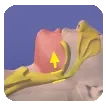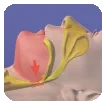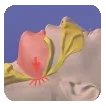If you suffer from snoring, you are not alone. Estimates say that between 30-50% of the population suffer from snoring. It disrupts your sleep as well as your partner's. For some couples, it is so disruptive that they end up sleeping in separate beds. Here is what happens:



CPAP (Continuous Positive Airway Pressure) machines have become the accepted standard for treating obstructive sleep apnea today. Despite the advantages of sleep apnea CPAP machines, many people experience problems with their use and are looking for CPAP alternatives.
Some studies estimate that only about 60% of CPAP machine users are compliant with their sleep apnea treatment. Below are some of the negative side effects or problems that can occur in trying to use a CPAP machine:
- The CPAP dries out your mouth and nose. Modern CPAP machines humidify the air to try to deal with this problem.
- If the nose is dried out, it becomes irritated, which may result in sneezing or congested and blocked nasal passages.
- If the air is humidified, you can have another problem called “rainout.” When the humidified CPAP air condenses, water can collect in the tubing and you can get splashed in the face.
- Poorly fitting or inappropriate CPAP masks.
- Facial hair can hinder the mask from being air tight.
- Trying to sleep with a mask over the face causes claustrophobia in some patients.
- Older sleep apnea machines, in particular, can have a distinct buzzing sound that may be disturbing. Newer machines are quieter but still make noise.
- The tubes and cords can become kinked or tangled. This may be one of the most bothersome problems and the biggest reason people look for CPAP alternatives.
- Some users have problems with stomach bloating because the CPAP machine forces air into the stomach.
Dr. Donaghey offer an alternative treatment for sleep apnea through the use of an oral appliance. The oral appliance works by positioning the lower jaw forward which helps to open the airway. The oral appliance is easier to travel with, does not have any cords or tubes, and does not make any nosie like the CPAP does. It also does not interference with a persons ability to sleep on their side or stomach.
